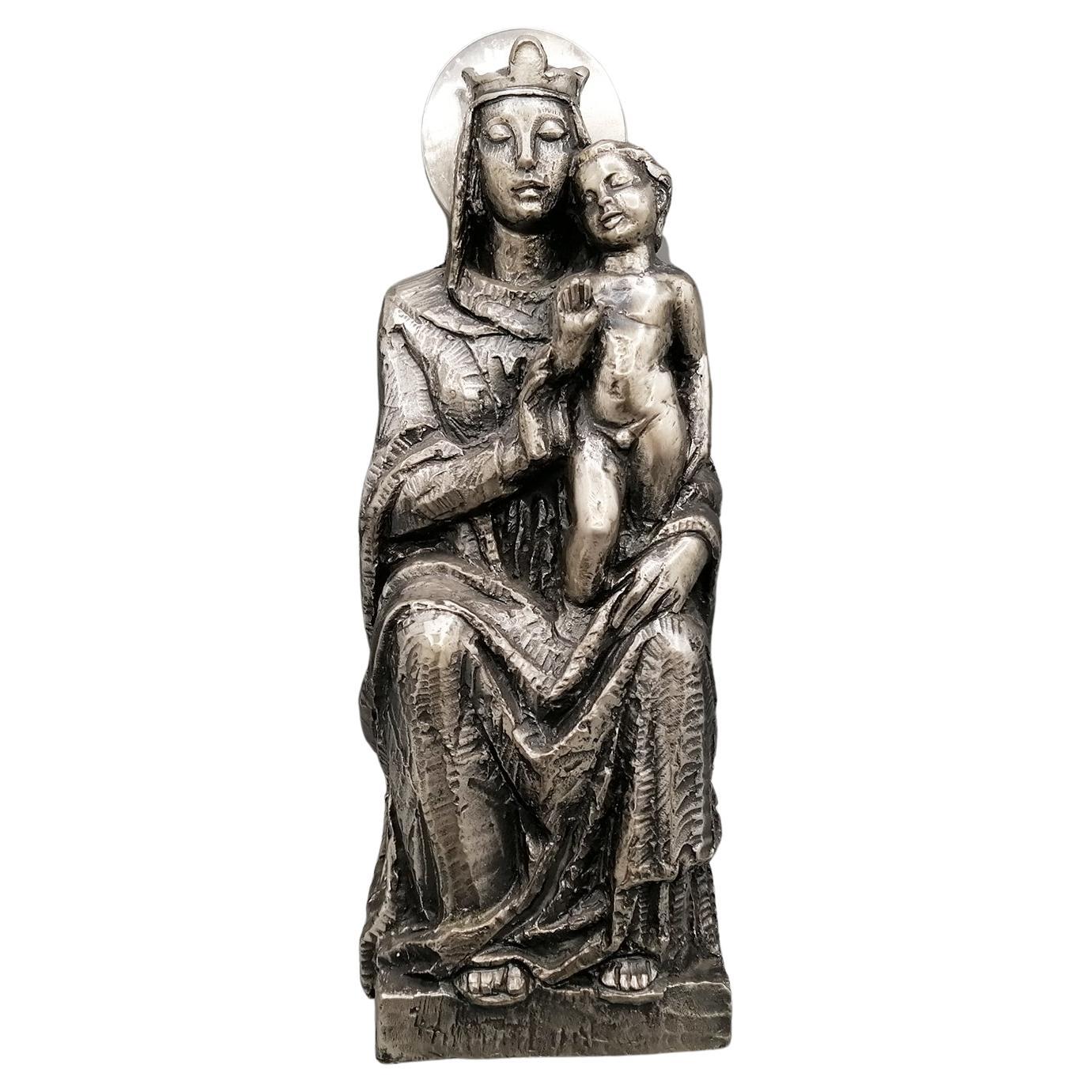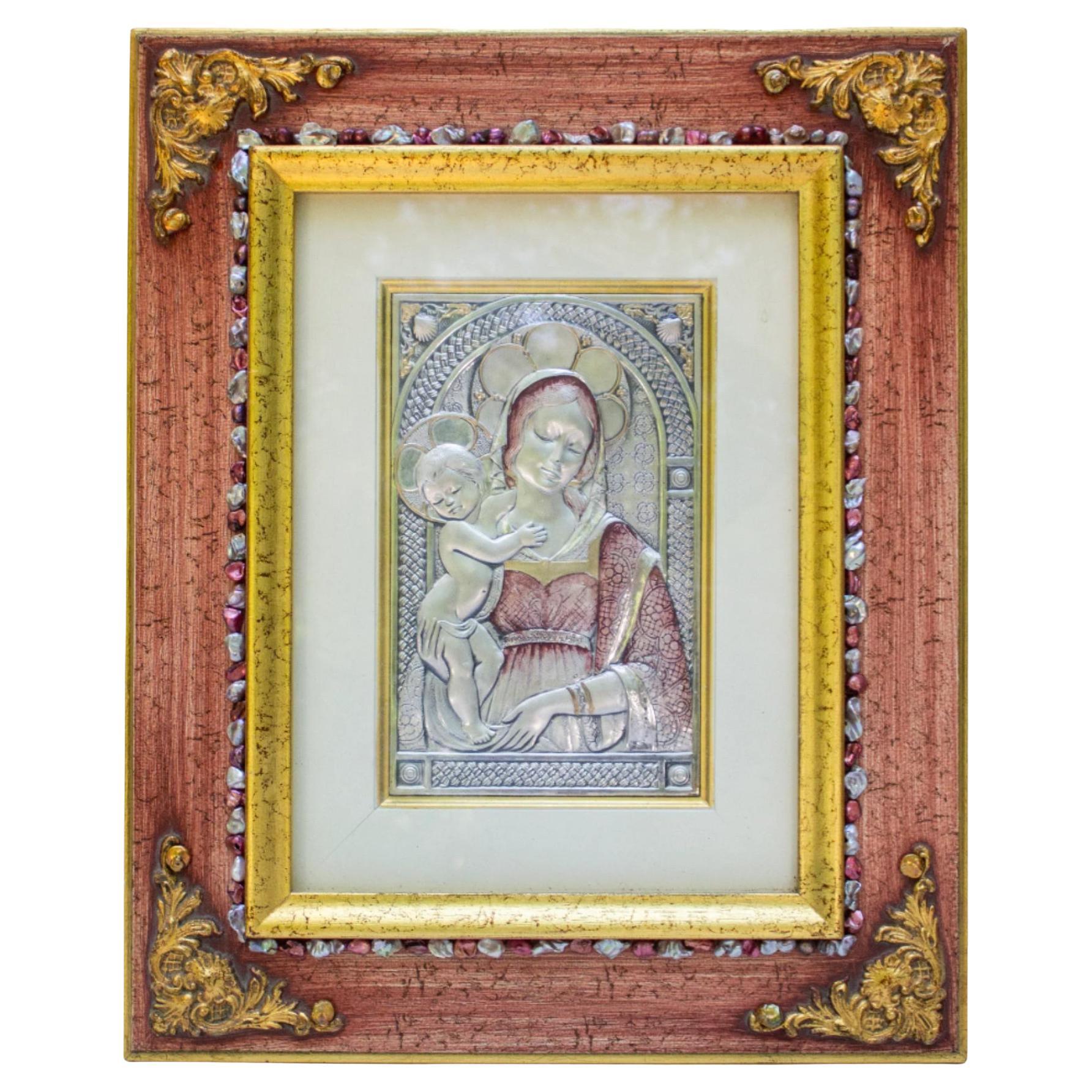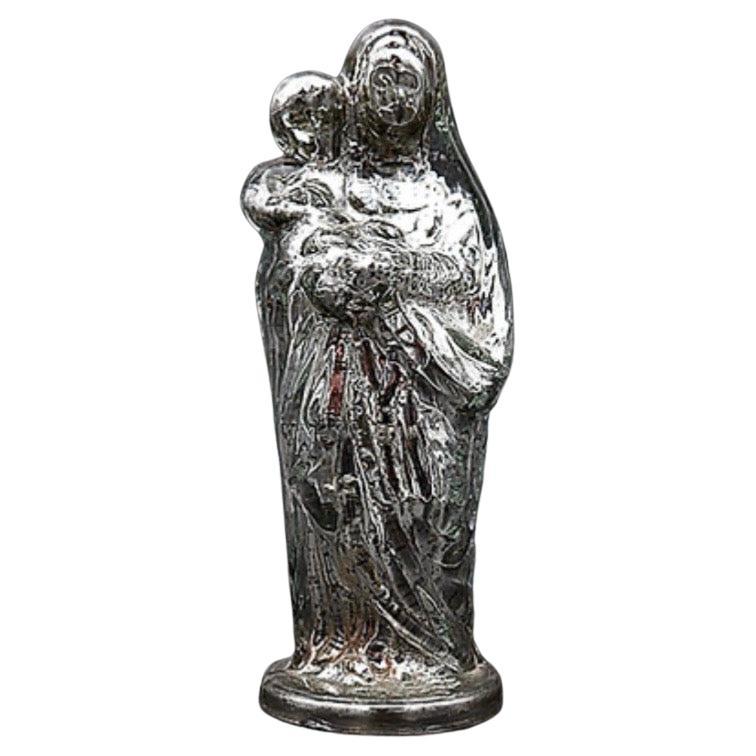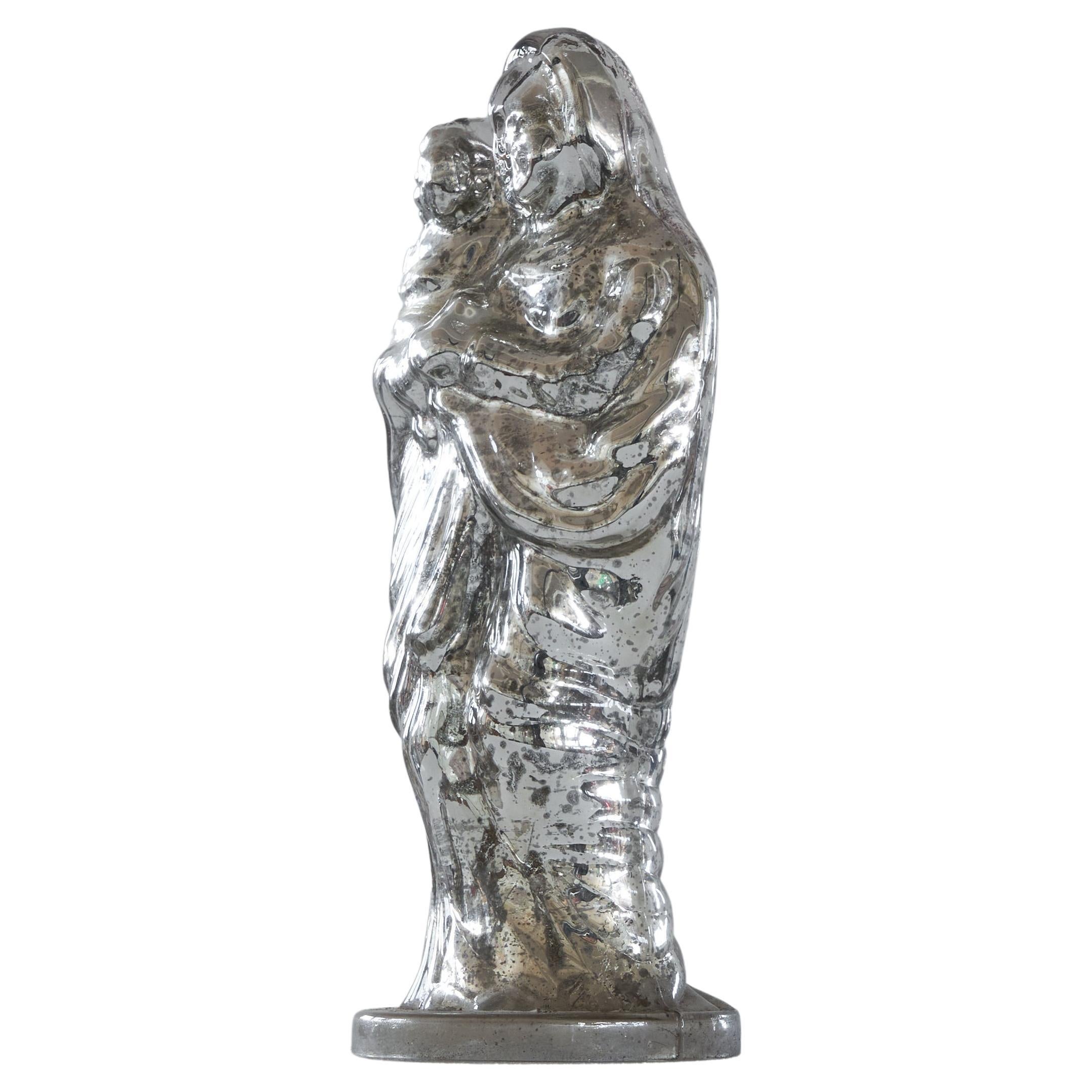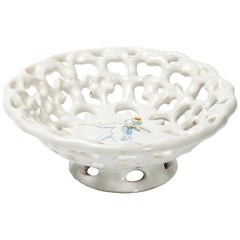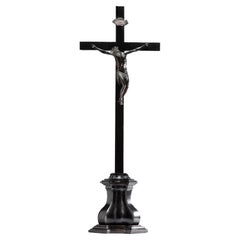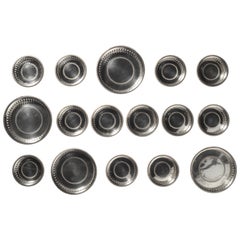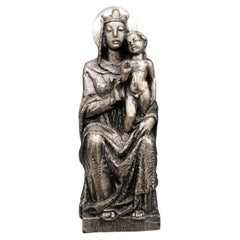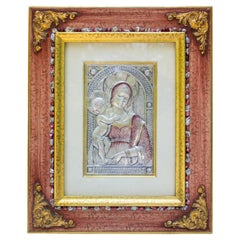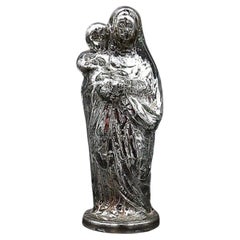Items Similar to 19th Century Italian Sterling Silver Madonna, circa 1830
Video Loading
Want more images or videos?
Request additional images or videos from the seller
1 of 22
19th Century Italian Sterling Silver Madonna, circa 1830
$7,221.88
£5,253.84
€6,000
CA$9,855.79
A$10,975.31
CHF 5,712.04
MX$135,324.27
NOK 72,747.24
SEK 68,375.35
DKK 45,662.79
Shipping
Retrieving quote...The 1stDibs Promise:
Authenticity Guarantee,
Money-Back Guarantee,
24-Hour Cancellation
About the Item
Embossed and engraved silver plaque
La Madonna del lago (The Madonna of the Lake)
Probably Milan, post 1824
Brass frame
It measures 16.14 in x 13.85 in (41 x 35.2 cm) and it weighs 10.357 pounds (4.698 g): silver 1.31 pounds (598 g) + brass 9.03 pounds (4.100 g)
State of conservation: some abrasions on the bottom. The frame is old, but not original.
The plaque is made up of a sheet of embossed and engraved silver, and held in a solid brass frame. It depicts the “Madonna del lago” – “Madonna of the Lake” - (the Madonna with Child and San Giovannino) by Marco d'Oggiono (Oggiono, 1474 circa - Milan, 1524 circa), while changing only the background landscape. Almost certainly the subject reproduced in the plaque was taken from a famous engraving by Giuseppe Longhi (Monza, 1766 - Milan, 1831), one of the greatest engravers of his era.
The silver is unmarked, probably because originally the Madonna was due to be exposed in a church: sometimes precious metals destined for worship and liturgical use would be exempted from payment and were, therefore, not marked.
It is very likely that the plaque was made in Milan because in this city in 1824 the engraving by Giuseppe Longhi was made and printed. In addition, in Milan, the alleged lost painting by Leonardo da Vinci in his Milanese period (1482-1500) would be produced; this is the painting from which Marco d'Oggiono took his version.
The painting
Marco d?Oggiono was one of Leonardo da Vinci's most brilliant students and collaborators (D. Sedini, Marco d’Oggiono, tradizione e rinnovamento in Lombardia tra Quattrocento e Cinquecento, Roma 1989, pp. 151-153, n. 56; p. 225, n. 124, with previous bibliography). His style reflects in every way that of the Tuscan Maestro, so much so that he was the one who executed some copies of da Vinci's paintings. The execution of the “Madonna del Lago” probably draws inspiration from a lost painting by the Maestro, created while he was living in Milan (1482-1500). There are many similarities with other works by Leonardo such as the “Vergine delle rocce” or the “Vergine con il Bambino e San Giovannino, Sant’Anna e l’Agnello”.
The painting, from which the drawing and then the famous engraving were taken, is found today at the M&G Museum of Bob Jones University in Greenville, South Carolina, where it came to rest after the sale of the Harrington Collection in London in 1917.
The work appears in the inventories of the collection of Napoleon and Joséphine Bonaparte at the castle of Malmaison, before 1809.
The Malmaison building was born and developed in the 17th and 18th centuries. In the 18th century it belonged to Jacques-Jean Le Coulteux du Molay, a wealthy banker. Later, during the Directory, Joséphine Bonaparte de Beauharnais bought it on April 21st, 1799, but settled at the castle definitively only after her husband separated from her in 1809. She remained there until 1814, the year of her death. When Joséphine died, the estate passed to her son Eugène de Beauharnais, who moved to Munich with his whole family in 1815, bringing with him the collection of paintings he inherited from his mother. Eugène died in 1824 and his wife Augusta of Bavaria (von Bayern), unable to keep it, in 1828 sold the Malmaison to the Swedish banker Jonas-Philip Hagerman.
It is likely that in this period Augusta also sold part of the paintings inherited from her husband, including the “Madonna del Lago”. This painting then came into the possession of Leicester Stanhope, fifth Earl of Harrington (1784 - 1862) and then was passed down to his descendants.
In 1917, at the death of Charles, eighth Earl of Harrington, his brother Dudley inherited the title and properties and he put up a part of his collections for sale. Among these, precisely, the painting by Marco d'Oggiono was to be found.
On the occasion of that auction the painting was presented as a work by Cesare da Sesto, by virtue of a handwritten note by the Countess of Harrington on the back of the table. However, already in 1857, the German critic Gustav Waagen had identified Marco d'Oggiono as the author of the painting, then exhibited in the dining room of Harrington House in London (Treasures of Art in Great Britain, in 4 volumes, London, 1854 and 1857).
The engraving
Giuseppe Longhi was one of the most renowned engravers in Italy between the end of the 18th century and the first quarter of the 19th century.
In 1824 Giuseppe Longhi, based on a design by Paolo Caronni, made a famous engraving of the painting of Marco d?Oggiono. The activity of Longhi was then at the peak of his notoriety, enough to earn him very substantial commissions; it is not risky to suppose that some of his successful engravings were also reproduced using other means: in our case in silver. (A. Crespi, a cura di, Giuseppe Longhi 1766–1831 e Raffaello Morghen, l’incisione neoclassica di traduzione, exhibition catalog Monza 11 Aprile -16 maggio 2010 p. 20 e p. 51 n. 59).
This news comes from Ferrario (vice-librarian in the Brera Library of Milan from 1816 and First Librarian since 1838), who wrote in 1836 about Caronni (1779 - 1842), who was active alongside his master Longhi in the engraving of works for the Galérie du Musée Napoleon as early as the beginning of the nineteenth century. Ferrario stated that "having the art of pen dashing par excellence, so that to distinguish one would not know such a drawing from a print conducted with all the finesse and neatness of the burin" (Ferrario G., Le classiche stampe dal cominciamento della Calcografia fino al presente, Tipografia di Santo Bravetta, Milano 1836, pp. 180-194).
A different view was held by Francesco Longhena, who in his biography stated that Longhi began to affect the “Madonna del lago” in 1824 with its own design taken directly from a painting of equal size and designed by Leonardo and painted by his pupil Marco d'Oggiono (in Notizie biografiche di Giuseppe Longhi collected and published by Francesco Longhena, Milano 1831 p. 32).
From the biography of the important and well-known engraver we know that he was engaged with contracts beyond the Alps; that he was summoned to meetings in Lyon as early as 1801 as one of the selected "thirty scholars", along with Bossi, Appiani and Rosaspina; that he was the author of copies of numerous paintings in the French capital as part of a project to reproduce a large number of works for the creation of the so-called Musée Napoleon. In fact, the suppression of religious orders had brought to Paris a great deal of masterpieces which, on an iconological level, constituted a significant opportunity for scholars to compare and a great opportunity for engravers to work.
His teaching at the Brera Academy was long and fruitful and led to the training of many of the most talented engravers of the time, such as Faustino Anderloni, Carlo Rampoldi, Pietro Anderloni and, indeed, Paolo Caronni. With the latter a close collaboration was born, ranging from the carving of the "Ezechiello" and of the "Quadroni di San Carlo" to the portraiture of Augusta Amalia of Bavaria up to the production of the “Madonna del Lago”, according to Ferrario.
Longhi died suddenly in 1831, an unequaled artist and engraver.
- Dimensions:Height: 16.15 in (41 cm)Width: 13.86 in (35.2 cm)Depth: 1.19 in (3 cm)
- Style:Neoclassical (Of the Period)
- Materials and Techniques:
- Place of Origin:
- Period:
- Date of Manufacture:circa 1830
- Condition:Minor losses. Minor fading. Some abrasions on the bottom. The frame is old, but not original.
- Seller Location:Milano, IT
- Reference Number:1stDibs: LU4352215317172
About the Seller
4.3
Vetted Professional Seller
Every seller passes strict standards for authenticity and reliability
Established in 1860
1stDibs seller since 2018
21 sales on 1stDibs
Associations
International Confederation of Art and Antique Dealers' Associations
- ShippingRetrieving quote...Shipping from: Milano, Italy
- Return Policy
Authenticity Guarantee
In the unlikely event there’s an issue with an item’s authenticity, contact us within 1 year for a full refund. DetailsMoney-Back Guarantee
If your item is not as described, is damaged in transit, or does not arrive, contact us within 7 days for a full refund. Details24-Hour Cancellation
You have a 24-hour grace period in which to reconsider your purchase, with no questions asked.Vetted Professional Sellers
Our world-class sellers must adhere to strict standards for service and quality, maintaining the integrity of our listings.Price-Match Guarantee
If you find that a seller listed the same item for a lower price elsewhere, we’ll match it.Trusted Global Delivery
Our best-in-class carrier network provides specialized shipping options worldwide, including custom delivery.More From This Seller
View AllAncient Italian Renaissance Maiolica Crespina, Faenza, 1580 Circa
Located in Milano, IT
Crespina
Faenza, last quarter of the 16th century
Maiolica painted in two colors, light blue and yellow, on a thick, rich layer of white enamel.
It measures 2.24 in (5.7 cm) in height, 6.10 in (15.5 cm) in diameter.
lb 0.55 (kg 0.25)
State of conservation: mimetic restoration.
The small cup has a raised central “umbone”, a perforated brim and a shaped rim. It rests on a high jutting foot. The "crespina" shape, in some inventories is cited as "tacce de frute" (fruit cups). It was particularly appreciated in the Renaissance and has variants based on the formal types and the different sizes. The decoration, made according to the dictates of the “compendiario” style, used few standardized colors: blue and yellow on a thick white and shiny enamel, deliberately chosen as the colour which was most reminiscent of silver. This choice derived from a trend in creative design of the era: the shapes used in the molds were often taken from metal objects. An idea which would last throughout the Renaissance.
The work shows, in the middle of the “umbone”, a winged putto stepping forward while playing a long thin trumpet.
The depiction of the putto is fully representative of the repertoire of the Faenza workshops of the sixteenth century.
Some specimens with this type of decoration have been published in a volume by Carmen Ravanelli Guidotti: there appears the whole productive repertoire of this fundamental moment of transition between the taste for the “istoriato” style and the great simplification of decoration in the “compendiario” period. This style, in its simplicity, however, saw its expression in a rather varied collection of decorative subjects, including old-fashioned busts...
Category
Antique 16th Century Italian Renaissance Ceramics
Materials
Maiolica
Crucifix, Bronze, iron, and wood, Lombardy, mid-17th century
Located in Milano, IT
Crucifix
Lombardy, mid-17th century
Bronze, iron, and wood
Sculpture: 33 cm height x 35 cm width x 10 cm depth at the knees;
Cross: 42.12 in height x 19.68 in width (107 cm x 50);
Ba...
Category
Antique Mid-17th Century Italian Baroque Figurative Sculptures
Materials
Bronze, Iron
Ancient Neoclassic Sterling Silver Coffee Pot, Palermo, Sicily circa 1789
Located in Milano, IT
Ancient Neoclassic Sterling Silver Coffee Pot, Palermo, Sicily circa 1789
Embossed and engraved silver coffee pot
Silversmith, probably Agostino Natoli
Diego Di Maggio, Silversmith Consul in 1789 and 1796
Palermo, 1789
It measures 14.17 in (36 cm) high and weighs 2.76 lb (1.252 g)
State of conservation: few signs of use and some slight blemishes
The large silver coffee pot has a round mouthpiece with a markedly everted rim, on which hinges a domed lid with very full molded pod shapes; a closed bud surmounted by a small sphere serves as a knob. The polygonal neck descends and widens into molded elements that come together, with larger pods, at the point where it is attached to the body. The body in turn is united to a well-shaped foot, which ends in a flat base with a vertical rim.
From the body rises a spout with a circular mouth accented with a thick rim. An angled loop, made of ebonized wood, is applied to the neck by means of a double-cone element having a sphere at its center; it ends in a silver cone...
Category
Antique 1780s Sicilian Neoclassical Sterling Silver
Materials
Sterling Silver
19th Century Italian Sterling Silver Glass and Wine Coasters, circa 1830
By Antonio Mantelli
Located in Milano, IT
Twelve silver glass coasters and four silver wine coasters.
Silversmith Antonio Mantelli
Milan, circa 1830
They measure:
Glass coasters: 0.78 in high x 3.46 in diameter (2 cm x 8.8 c...
Category
Antique 1820s Italian Neoclassical Sterling Silver
Materials
Sterling Silver
Large Italian Neoclassic Sterling Silver Coffee Pot, Milan, Circa 1830
Located in Milano, IT
Embossed and engraved silver coffee pot
Antonio Garavaglia
Milan, Circa 1830
It measures 16.92 in (43 cm) in height and weighs 3.35 lb (1.520 gr)
State of conservation: very good
The large silver coffee pot has a round mouthpiece with a marked everted rim on which a pagoda lid rests; this is surmounted by a cock-shaped knob with a border decorated with small pods...
Category
Antique 1820s Italian Neoclassical Sterling Silver
Materials
Sterling Silver
Ancient Italian Neoclassic Sterling Silver Coffee Pot, Milan, circa 1850
Located in Milano, IT
Embossed and engraved sterling silver coffee pot
Tommaso Panizza (1805-1868)
Milan, circa half of the 19th century
It measures 13.97 in (cm 35.5) in height x 8.66 in (22 cm) x 4.7...
Category
Antique 1840s Italian Neoclassical Sterling Silver
Materials
Sterling Silver
You May Also Like
Italian Solid 800 Silver Statue depicting the Virgin Mary and Child blessing
By Mario Vallè
Located in VALENZA, IT
Hanging statue depicting the Madonna and Child blessing, seated on the throne.
It was made with the sand/earth casting technique, finely chiseled and subsequently burnished and treat...
Category
Vintage 1970s Italian Other Religious Items
Materials
Silver
Italian Hand-Made Silver Madonna and Child from Sicily in Antique Wood Frame
By Interi
Located in Dublin, Dalkey
Italian hand-hammered silver Madonna and child from Sicily, detailed with gold and light red-wine hues, perfectly coordinating with the original Sicilian wood frame. The inner frame ...
Category
20th Century Italian Rococo Decorative Art
Materials
Gold Leaf, Silver
Vintage French Silvered Pewter Holy Water Stoup with Virgin Mary Jesus & John
Located in Dallas, TX
Decorate a chapel or entry with this early 20th-century French holy water stoup. Resting on a black marble plaque, the religious stoup features a finely detailed pewter relief portraying the Virgin Mary tenderly holding Baby Jesus, with John the Baptist kneeling beside them. The figures are rendered with exquisite detail, showcasing delicate facial expressions and intricate drapery. The dark, shield-shaped marble base adds a solemn, elegant contrast to the silvery pewter figures...
Category
Early 20th Century French Religious Items
Materials
Marble, Pewter
Antique Patinated Mercury glass Madonna with child - 20th century
Located in Linkebeek, BE
Antique Patinated Mercury glass Madonna with child - 20th century
Wear consistent with age and use
Devotional statue - Antique Decoration
This is a mercury glass Madonna with child...
Category
Early 20th Century Religious Items
Materials
Glass, Mercury Glass
Large Antique Patinated Mercury Glass Madonna with Child
Located in Tilburg, NL
Antique patinated Mercury glass Madonna with child. Turn of the century / early 20th century.
This is a wonderful and large mercury glass Madonna with child figurine...
Category
Early 20th Century Unknown Aesthetic Movement Figurative Sculptures
Materials
Glass, Mercury Glass
Antique Madonna & Child Sculpture/Religious Icon, Italy 19th Century
Located in Los Angeles, CA
Introducing our exquisite Antique Madonna & Child Sculpture/Religious Icon, originating from 19th-century Italy. This captivating masterpiece showcases...
Category
Antique 19th Century Italian Revival Figurative Sculptures
Materials
Wood, Giltwood
